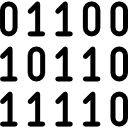Cache memory: Difference between revisions
Mr. MacKenty (talk | contribs) (Created page with "frame|right|This is a basic concept in computer science The primary memory stores the program instructions and the data in binary machine code. The Contro...") |
Mr. MacKenty (talk | contribs) No edit summary |
||
| Line 1: | Line 1: | ||
[[File:binary.png|frame|right|This is a basic concept in computer science]] | [[File:binary.png|frame|right|This is a basic concept in computer science]] | ||
Cache is very fast and small memory that is placed in between the CPU and the main memory. | |||
Cache memory is used to reduce the average memory access times. This is done by storing the data that is frequently accessed in main memory addresses therefore allowing the CPU to access the data faster. This is due to the fact that cache memory can be read a lot faster than main memory. There are different types of cache (e.g. L1,L2 and L3)<ref>https://compsci2014.wikispaces.com/2.1.3+Explain+the+use+of+cache+memory</ref> | |||
== Do you understand this topic? == | == Do you understand this topic? == | ||
Revision as of 12:05, 25 August 2016
Cache is very fast and small memory that is placed in between the CPU and the main memory. Cache memory is used to reduce the average memory access times. This is done by storing the data that is frequently accessed in main memory addresses therefore allowing the CPU to access the data faster. This is due to the fact that cache memory can be read a lot faster than main memory. There are different types of cache (e.g. L1,L2 and L3)[1]
Do you understand this topic?[edit]
- Describe primary memory.
Do you have an advanced understanding about this topic?[edit]
- Explain why investing in primary memory may provide better performance than secondary memory.
